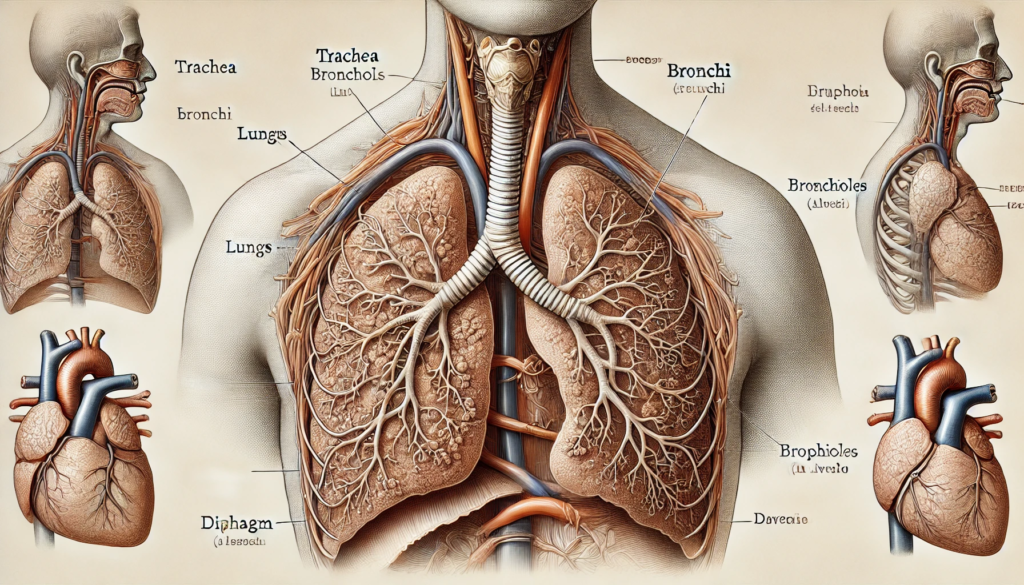The respiratory system is a crucial organ system responsible for the exchange of oxygen and carbon dioxide between the body and the environment. It consists of various structures, including the lungs, bronchi, trachea, and diaphragm, that work together to facilitate breathing. This article provides an overview of the anatomy and function of the respiratory system, focusing on the lungs and bronchi, and the process of breathing.
Anatomy of the Respiratory System
The respiratory system is divided into the upper and lower respiratory tracts, each comprising specific anatomical structures that play essential roles in respiration.
1. Upper Respiratory Tract
The upper respiratory tract includes the following structures:
- Nose and Nasal Cavity: The primary entry point for air, the nose filters, warms, and humidifies the air before it reaches the lungs. The nasal cavity is lined with cilia and mucus to trap dust and pathogens.
- Pharynx (Throat): A muscular tube that connects the nasal cavity and mouth to the larynx and esophagus. It serves as a passageway for air and food.
- Larynx (Voice Box): Located below the pharynx, the larynx houses the vocal cords and is responsible for sound production. It also acts as a protective mechanism, preventing food and liquids from entering the lower respiratory tract during swallowing.
2. Lower Respiratory Tract
The lower respiratory tract includes the following structures:
- Trachea (Windpipe): A flexible tube that extends from the larynx to the bronchi. It is supported by C-shaped cartilage rings that keep the airway open. The trachea serves as the main passageway for air to enter and exit the lungs.
- Bronchi and Bronchioles: The trachea divides into the left and right primary bronchi, which lead to each lung. The bronchi further branch into smaller bronchioles, forming a network of airways that deliver air to the alveoli.
- Lungs: The primary organs of the respiratory system, the lungs are located on either side of the thoracic cavity. Each lung is divided into lobes (three on the right and two on the left) and contains millions of alveoli, tiny air sacs where gas exchange occurs.
- Alveoli: Small, balloon-like structures at the end of the bronchioles. The alveoli are surrounded by a network of capillaries and are the site of oxygen and carbon dioxide exchange between the air and the blood.
- Diaphragm: A dome-shaped muscle located at the base of the lungs. The diaphragm plays a crucial role in breathing by contracting and relaxing to change the volume of the thoracic cavity.
The Process of Breathing
Breathing, or ventilation, is the process of moving air in and out of the lungs. It consists of two phases: inspiration (inhalation) and expiration (exhalation).
1. Inspiration (Inhalation)
Inspiration is the process of drawing air into the lungs. It involves the following steps:
- Diaphragm Contraction: During inspiration, the diaphragm contracts and flattens, increasing the volume of the thoracic cavity. This creates negative pressure within the lungs, causing air to flow in.
- External Intercostal Muscles: These muscles, located between the ribs, contract to elevate the rib cage and further expand the chest cavity.
- Airflow: The increase in thoracic volume decreases the pressure within the lungs, causing air to flow in through the nose or mouth, down the trachea, and into the bronchi and bronchioles.
2. Expiration (Exhalation)
Expiration is the process of expelling air from the lungs. It can occur passively or actively:
- Passive Expiration: In quiet breathing, expiration is primarily a passive process. The diaphragm and external intercostal muscles relax, causing the thoracic cavity’s volume to decrease. This increase in pressure within the lungs forces air out.
- Active Expiration: During forced breathing or physical exertion, expiration becomes an active process. The internal intercostal muscles and abdominal muscles contract, further decreasing thoracic volume and increasing pressure to expel air more forcefully.
Gas Exchange and Transport
The primary function of the respiratory system is to facilitate gas exchange, supplying oxygen to the body and removing carbon dioxide. This process occurs in the alveoli through diffusion.
1. Oxygen Transport
When air reaches the alveoli, oxygen diffuses across the thin alveolar walls into the surrounding capillaries. Oxygen binds to hemoglobin molecules in red blood cells and is transported through the bloodstream to tissues and organs.
2. Carbon Dioxide Removal
Carbon dioxide, a waste product of cellular metabolism, diffuses from the blood into the alveoli. It is then expelled from the lungs during expiration. The removal of carbon dioxide helps maintain the body’s acid-base balance and prevent acidosis.
Functions of the Respiratory System
The respiratory system serves several essential functions beyond gas exchange, including:
1. Regulation of Blood pH
The respiratory system helps regulate blood pH by controlling the levels of carbon dioxide. An increase in carbon dioxide leads to the formation of carbonic acid, lowering blood pH. The lungs can adjust the rate and depth of breathing to maintain pH balance.
2. Protection Against Pathogens
The respiratory system provides a first line of defense against pathogens. The nasal cavity’s mucus and cilia trap and remove particles, while the cough reflex helps expel irritants from the airways.
3. Sound Production
The larynx houses the vocal cords, which vibrate to produce sound when air passes through them. This allows for speech and communication.
4. Olfaction (Sense of Smell)
The nasal cavity contains olfactory receptors that detect airborne chemicals, allowing for the sense of smell.
Common Respiratory Disorders
The respiratory system can be affected by various disorders, ranging from mild to severe. Some common respiratory disorders include:
1. Asthma
Asthma is a chronic condition characterized by inflammation and narrowing of the airways, leading to difficulty breathing, wheezing, and coughing. It can be triggered by allergens, exercise, cold air, or respiratory infections.
2. Chronic Obstructive Pulmonary Disease (COPD)
COPD is a group of progressive lung diseases, including emphysema and chronic bronchitis, that cause airflow obstruction and breathing difficulties. It is often associated with smoking and long-term exposure to lung irritants.
3. Pneumonia
Pneumonia is an infection that inflames the air sacs in the lungs, causing them to fill with fluid or pus. It can be caused by bacteria, viruses, or fungi and often presents with symptoms such as cough, fever, and shortness of breath.
4. Pulmonary Embolism
A pulmonary embolism occurs when a blood clot travels to the lungs and blocks a pulmonary artery. This can cause sudden shortness of breath, chest pain, and, in severe cases, death.
5. Lung Cancer
Lung cancer is a malignant tumor that originates in the lungs. It is one of the leading causes of cancer-related deaths worldwide. Risk factors include smoking, exposure to secondhand smoke, and environmental pollutants.
Conclusion
The respiratory system is a vital organ system that plays a crucial role in maintaining life by facilitating gas exchange, regulating blood pH, and protecting against pathogens. Understanding the anatomy and function of the respiratory system is essential for recognizing the importance of maintaining lung health and preventing respiratory disorders. By adopting healthy lifestyle habits, such as avoiding smoking, staying active, and practicing good hygiene, individuals can support the optimal functioning of their respiratory system.
FAQs
What is the primary function of the respiratory system?
The primary function of the respiratory system is to facilitate gas exchange, supplying oxygen to the body and removing carbon dioxide.
How do the lungs protect against infections?
The lungs protect against infections through the mucus and cilia in the airways, which trap and remove pathogens and particles. The cough reflex also helps expel irritants from the respiratory tract.
What is the role of the diaphragm in breathing?
The diaphragm is a dome-shaped muscle that plays a key role in breathing. It contracts and flattens during inspiration, increasing the volume of the thoracic cavity and allowing air to enter the lungs.
What causes asthma?
Asthma is caused by inflammation and narrowing of the airways, which can be triggered by allergens, respiratory infections, exercise, cold air, and other factors.
How can I maintain a healthy respiratory system?
To maintain a healthy respiratory system, avoid smoking, stay physically active, practice good hygiene, and minimize exposure to pollutants and allergens.
What is the difference between the upper and lower respiratory tracts?
The upper respiratory tract includes the nose, nasal cavity, pharynx, and larynx, while the lower respiratory tract consists of the trachea, bronchi, bronchioles, and lungs. The upper tract primarily filters, warms, and humidifies air, while the lower tract facilitates gas exchange.



